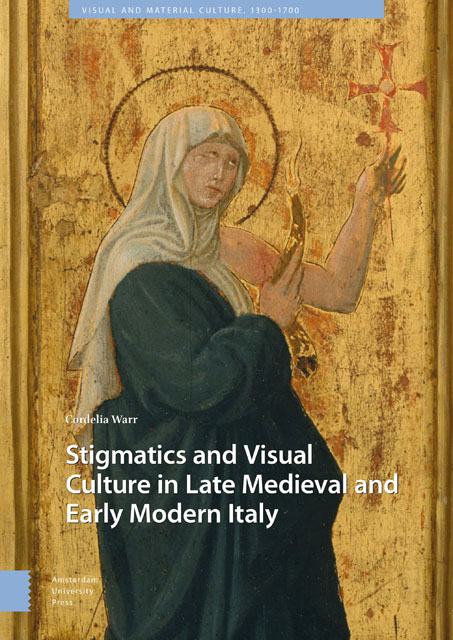Book contents
- Frontmatter
- Table of Contents
- Acknowledgements
- List of Illustrations
- 1 Introduction: Stigmata and Visual Culture
- 2 Saint Francis of Assisi as Image
- 3 Representing the Invisible: Saint Catherine of Siena’s Stigmatization
- 4 The Stigmatic Spectrum and the Visual Arts
- 5 Gregorio Lombardelli, Invisibility, and the Representation of Saint Catherine of Siena’s Stigmata
- 6 Performing Stigmata
- 7 Painting, Printing, Sculpting, Forgery (and Washing)
- 8 Conclusion: The Timidity of the Visual Arts
- Complete Bibliography
- Index
8 - Conclusion: The Timidity of the Visual Arts
Published online by Cambridge University Press: 06 December 2022
- Frontmatter
- Table of Contents
- Acknowledgements
- List of Illustrations
- 1 Introduction: Stigmata and Visual Culture
- 2 Saint Francis of Assisi as Image
- 3 Representing the Invisible: Saint Catherine of Siena’s Stigmatization
- 4 The Stigmatic Spectrum and the Visual Arts
- 5 Gregorio Lombardelli, Invisibility, and the Representation of Saint Catherine of Siena’s Stigmata
- 6 Performing Stigmata
- 7 Painting, Printing, Sculpting, Forgery (and Washing)
- 8 Conclusion: The Timidity of the Visual Arts
- Complete Bibliography
- Index
Summary
Abstract
Descriptions of stigmata can be terse, but they often engender a strong visual image in the mind's eye. Again and again we are led to think about shining silver coins, unyielding flesh growths, rose-coloured areas of raised flesh, flowing blood repeatedly absorbed into pieces of linen cloth. Understanding stigmata was heavily dependent on visual references. Stigmatic behaviours could call to mind harrowing sculptures of Christ crucified and were influenced by those sculptures. By contrast, many paintings and sculptures of stigmatics appear restrained. They contained little sign of the physical suffering caused by the stigmata with the connection to Christ's agonies implied rather than explicit and the wounds minimised. The chapter explores this apparent paradox.
Keywords: Dominicans, meditation, nails, Council of Trent, stigmata
The descriptions of stigmata in vitae can be terse but they often engender a strong visual image in the mind's eye. Again and again we are led to think about shining silver coins, flesh growths which cannot be bent or squashed, rose-coloured areas of raised flesh, blood flowing to the extent that it can be collected by being absorbed, repeatedly, into pieces of linen cloth. The ways in which stigmata were understood were heavily dependent on visualization and on visual references. Stigmatic behaviours could call to mind harrowing sculptures of Christ crucified and were influenced by those sculptures. By contrast, some paintings and sculptures of stigmatics can appear restrained. They contained little sign of the physical suffering caused by the stigmata and the connection to Christ's agonies was implied rather than explicit.
One example of restraint in the visual representation of a stigmatic is the monument for Maria Raggi in Santa Maria sopra Minerva, Rome (circa 1647–1653), by Gian Lorenzo Bernini (1598–1680). The ways in which the stigmata on Maria's hands were described in her vitae as shining like coins were discussed in the previous chapter. Bernini's sculpture is located on a pier in the nave and is made of marble and bronze (fig. 70). The bust of Maria is presented in an oval medallion supported by two putti and placed against a black marble representation of hanging drapery surmounted by a cross and with an inscription placed at the bottom.
- Type
- Chapter
- Information
- Publisher: Amsterdam University PressPrint publication year: 2022



